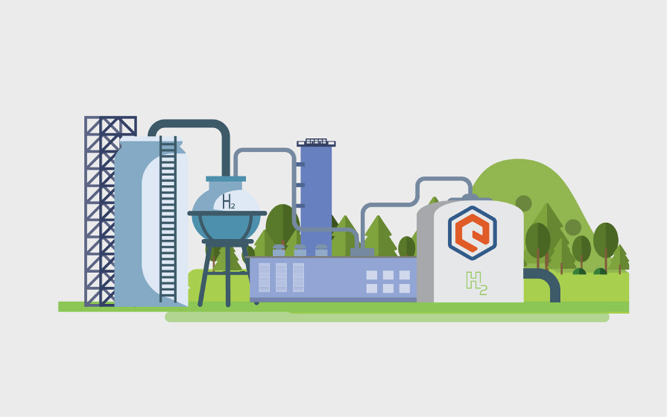Clean Hydrogen In A Hurry: Ekona’s Pulsed-Methane Pyrolysis Solution Bypasses CCS Needs
By Carter Haydu
Wednesday, September 27, 2023, 7:48 AM MDT
Ekona Power Inc.’s pulsed-methane pyrolysis converts methane into hydrogen and solid carbon, which eliminates the need for carbon capture and storage (CCS) infrastructure for those wanting to produce hydrogen, says Chris Reid, co-founder and chief executive officer of the Vancouver-based company.
“The only thing our process uses is natural gas feedstock, and so you can set yourself up anywhere along the natural gas grid,” he told the Bulletin. The best approach to the energy transition is to do it quickly, he said, and utilizing existing infrastructure offers the fastest, most economical pathway forward. “Our whole vision with our technology is that natural gas is the best carrier of hydrogen. We already have a complete natural gas grid.”
Reid added: “This technology can be sited right on the gas line. It’ll be the lowest-cost clean hydrogen you can get. Depending on what you do with the carbon, it can be directly [cost] competitive with ‘grey’ hydrogen. If you’re using hydrogen today, then I’d say this is the way to go — right away.”
How it works
The pyrolysis reactor uses pulse-combustion and high-speed gas dynamics to dissociate feedstock methane. The feedstock natural gas is loaded in a vessel and pre-heated to around 1,000 kelvin. The feedstock is then mixed with more natural gas and oxygen that is combusted at high pressure, said Reid. The methane pyrolyzes and breaks down into solid carbon and hydrogen.
“We then open the exit valve, everything goes out including a hydrogen-rich syngas, water and solid carbon. From there, it goes through a heat exchanger for pre-heating the feedstock gas, a water separator, and then into a carbon separator. The carbon is taken out, and then it goes into a pressure swing absorption system, which is used in the industry to purify hydrogen. The gas is then purified and it’s sent to the customer.”
Any unprocessed methane is recycled back into the reactor with new feedstock, he added.
Cost-competitive approach
The cost of making grey hydrogen through steam-methane reforming is about $1.20 per kilogram, according to Ekona’s CEO. To make so-called ‘blue’ hydrogen, which is grey hydrogen plus CCS, the cost is about $2 per kilogram. For ‘green’ hydrogen, which uses electrolysis with renewables, the cost can be much higher — up to $6 per kilogram.
Meanwhile, the cost for making ‘turquoise’ hydrogen with pulsed-methane pyrolysis comes to about $1.30 to $1.40 per kilogram at larger industrial scales (and without any value on the carbon).
Fortunately, noted Reid, his company’s process produces solid carbon black that could sell potentially at $100 to $300 per tonne depending on the market. Once the value of this byproduct is factored into the equation, he added, turquoise is more economical than grey. “If you’re trying to decarbonize your energy system and you’re trying to decarbonize your natural gas usage, which is hard to do, this will be the lowest-cost way to do it.”
A brief history of Ekona
In 2016, the founders of Ekona engaged Canadian oil and gas producers — mostly current Ekona investors Suncor Energy Inc. and Cenovus Energy Inc. — about how to make clean hydrogen in the most cost-effective way possible. Reid told the DOB: “We talked about what it would look like, what the cost needed to be and what the carbon intensity needs to be, what deployability needs to look like and what reliability needs to look like — all of those kinds of things.”
Unfortunately, he noted, at the time there was no hydrogen-production method to meet the required specifications. And so, his team came up with its pulse-methane pyrolysis solution, captured the intellectual property and created the company in 2017. Through their investment partnership, Evok Innovations, Suncor and Cenovus invested $2 million into Ekona. From there, Reid said, his company raised about $10 million in non-diluted funding.
“We built a proof-of-concept device that worked. And then we did a Series-A [that closed last year], which yielded $70 million into the treasury — a very successful Series-A.”
Next steps
Currently, Ekona is testing a 200 kilogram-per-day reactor right in its facility, and the company is installing a one-tonne-per-day system to be commissioned in the back half of 2024 with one of its Alberta investors. Ekona is ‘actively engaged’ in discussions to install several other units for a variety of applications around the globe. In total, suggested Reid, Ekona is in conversations with dozens of companies keenly interested in the technology.
“Most of our customers are going to be 20, 100 or even 500 tonnes per day. And so, this one [tonne-per-day] plant will be a pilot for them to understand how it works and what it looks like. We’ll scale that reactor up over the next couple of years so we can build the next nominal size at about 20 tonnes per day and then to 100, 300 and even to 500 tonnes per day.”
Baker Hughes Company led the Series-A investors, which consisted largely of North American oil and gas producers, he said, as well as midstream and downstream firms and investors from Southeast Asia and Japan, where CCS infrastructure is lacking.
In summary, Ekona offers a clean, affordable solution, Reid added. “We have everything you need. The hydrogen infrastructure is already there. It’s in the natural gas grid and our LNG infrastructure. As I say, natural gas is a great carrier of hydrogen. We can go fast on this.”
-//-
Many thanks to the Daily Oil Bulletin for the recent feature story about Ekona and for giving us permission to post the article in full on our website. View this article and other great content at the Daily Oil Bulletin here.

